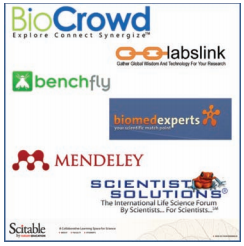The world of social media extends well past Facebook, Twitter, and the dozens (and there are dozens—198 at last count1) of other options for sharing a little or a lot with family, friends, professional colleagues, and so on. Beyond those are online communities that support researchers in a number of scientific disciplines. Cold Spring Harbor Laboratory provides an excellent, comprehensive guide to the categories of social media2 that are of value to the research community.
As of April 2013, there were just over 2 dozen Web sites that provided places for sharing and tracking research, from Academia.edu, started in 2008 with a “growing community of 2,499,686 academics”,3 to Yammer, a private social network used by more than 200,000 sci-tech–oriented companies around the world.4
If you are interested in reaching your members and community at large through social media, research these online communities that are focused on various academic fields. Scientific publishing is concerned with communicating with researchers who must identify the discipline-specific interests of their colleagues.
- Academia.edu

- Benchfly
- bevalley
- BioCrowd
- BiomedExperts
- BioSpace
- Epernicus
- LabLife
- LaboraTree
- LabRoots
- LabsLink
- LabSpaces
- medCrowd
- MedXCentral
- Mendeley
- MyNetResearch
- MySDscience
- Nature Network
- New Media Medicine
- Orwik
- PHYZOOM
- Research Crossroads
- ResearcherID
- ResearchGATE
- Science 2.0
- Scientist Solutions
- ScienceStage
- SciLink
- Sci-Mate
- Sciweavers
- Sciyo.com
- Sequilab
- Sermo
- The Science Advisory Board
- Tiromed
- VIVO
- Web of Medicine
- Within3
One of the online communities has made the news recently as having been acquired by Reed Elsevier in April 2013. Mendeley, a free reference manager and academic social network, was developed so that researchers could
- “Collaborate . . . with colleagues and securely share papers, notes and annotation.
- Backup, Sync and Mobile . . . access . . . papers on the web, iPhone or iPad.
- Network and Discover . . . papers, people and public groups.”5
In addition to all those online communities, a number of tools focus on various activities that are integral to research and publication activities.
Shared any good data lately?
Before social media, data were transferred via all sorts of less optimal methods: paper (lots of paper), computer disks (floppy and otherwise), and electronic files via ftp or USB drives, to name a few. Now Web sites, such as DataCite (http://datacite.org), formed at the end of 2009, fulfill their aims to “establish easier access to research data on the Internet; increase acceptance of research data as legitimate, citable contributions to the scholarly record; [and] support data archiving that will permit results to be verified and re-purposed for future study.”6 Other major sites for data sharing are BioMart, BioSharing.org, and figshare.com.
Are you a leader or a follower?
Brian Conlin, a copywriter at Vocus, shared “5 ways to attract social media followers”.7 For those interested in creating a group of followers for their organizations, Conlin’s advice is straight forward:
- “Be specific. Using the right keywords is essential. . . . Don’t rely on a single keyword to do all the work.
- Check the metrics. Knowing which social-media sites your [members] use is half the battle.
- Search social media. . . . a 24×7 parlor that savvy [professionals] can sweep for intelligence about their [organizations] and products.
- Adjust to friends. . . . Develop and adjust your cache of keywords by regularly monitoring social media and identifying industry and search trends.
- Produce content for your ideal customer. . . . Produce social content that closely matches the interests and needs of your target audience members.”
- Wikipedia article listing active social networking Web sites, excluding online dating. Available at: http://en.wikipedia.org/wiki/List_of_social_networking_websites. Accessed 7 April 2013.
- Social Media for Scientists/Scholars— LibGuides at Cold Spring Harbor Laboratory. Available at: http://cshl.libguides.com/print_content.php?pid=2476 53&sid=2045373&mode=g. Accessed 7 April 2013.
- Academia.edu Web site: http://www.academia.edu. Accessed 8 April 2013.
- Yammer Web site: https://www.yammer.com. Accessed 18 April 2013.
- Mendeley Web site: http://www.mendeley.com/features/. Accessed 16 May 2013.
- DataCite Web site. Available at: http://datacite.org/whatisdatacite. Accessed 7 April 2013.
- Conlin, Brian. “5 ways to attract social media followers” PR Daily blog, posted 28 January 2013. http://www.prdaily.com/Main/Articles/5_ways_to_attract_social_media_followers_13681.aspx
